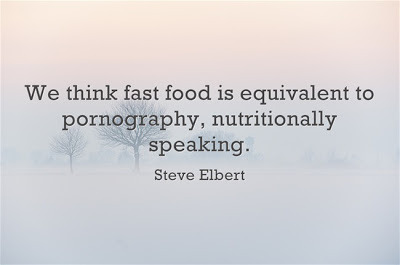Chris Pedersen's Blog, page 23
May 17, 2013
Prisoner Hit #1

So excited about our FREE for the first time promo for The Prisoner of Carrot Castle. We reached #1 for iPad book apps. So many little ones hearing and interacting with a fun and imaginative story to help them like veggies.
The promo is still on. So get to the App Store and download your copy FREE.

Sale ends at the end of the day Sunday, May 19th.


Published on May 17, 2013 15:36
May 13, 2013
Unveiling The Prisoner of Carrot Castle Book at A Day on the Farm
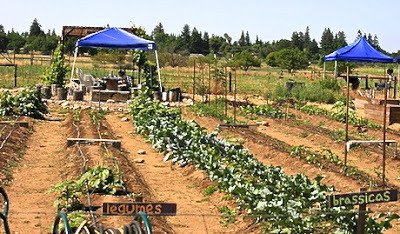
THIS IS A RAIN OR SHINE EVENT
A Day on the Farm
Learn, Eat & Celebrate!
Sunday • May 19 • 10am - 3pm • $5 per person
American River Ranch • Next to Hagan Park • Rancho Cordova
 $5 per person kids & adults
$5 per person kids & adults
(2 yrs and under free)
pay at the gate (cash only)
proceeds benefit
The Day's Events Include:
Farm Stand
Purchase fresh, local, organic vegetables & fruit
 Cooking Classes & Workshops
Cooking Classes & WorkshopsFarm Tours & Nature Walks
Kid's Garden Activities
Face Painting & Photo Booth
Community Education Tables
Local Arts & Crafts
Live Music: Mind X Quartet & More!
Morning Food, Snacks & Lunch
Learn About:
American River's Native Plants
Gardening • Composting
Raising Chickens
Beekeeping • Cooking
Native Edibles • More
Mark your calendars! I will be at A Day on the Farm at Soil Born Farm in Rancho Cordova. Buy a copy of The Prisoner of Carrot Castle and get it signed. Buy carrots and broccoli. Enjoy a salad toss. Juggle veggies. Lots of fun things to see and do.
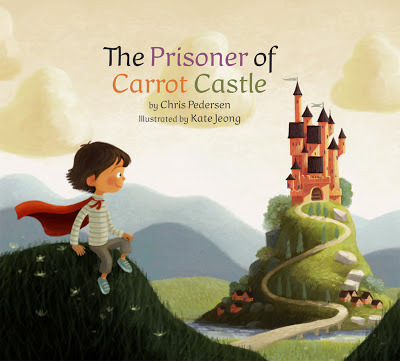
To celebrate the launch of the book in print, the iPad version is FREE for the first time ever! Hurry! FREE offer is good from May 16-19!
Download The Prisoner of Carrot Castle on your iPad FREE
(May 16-19)


Published on May 13, 2013 16:30
May 10, 2013
KISS Chili Recipe

Okay, it's high time you learn about the way I really cook. In hopes that you can learn to do the same.
When my friend Joanne Kraft began to prod, beg and coerce me to set up a blog so I could help people navigate the road to wellness plus provide delicious, healthy recipes, I protested loudly. I typically don't use recipes. I open my cabinets and refrigerator and make up meals. The simpler the better. You know... the KISS method(—Keep It Simple Stupid/Silly/(fill-in your own word that starts with an S).
I've told you in My Cancer Fighting Lifestyle that most meals consist of fish (wild-caught, of course) either grilled or baked and rubbed with spices served with some roasted or steamed veggies or salad. I love to throw together stir-fry veggie meals too. So easy. Stir up a batch of cut-up veggies in a couple tablespoons of olive oil. Add some Bragg's Liquid Aminos, the best and healthiest soy sauce alternative. Liquid Aminos is full of essential amino acids, 310 mg of protein in 1/2 teaspoon.
This quick chili recipe is a great example of a typical meal I'd make up. I pulled it together one evening and found it delicious and satisfying. For the flavors to be right, its key to use spice amounts appropriate for your family's taste. I've mentioned before that the heat of chili powders will vary so I listed the chili powder amount as a dash. Of course you'll add more than a dash, but be aware of how hot it may make your chili.
For a topping, I used Daiya non-dairy grated cheese. You can use your favorite grated cheese, but remember you want to use organic to ensure no GMOs, antibiotics or hormones in your food.
KISS Chili
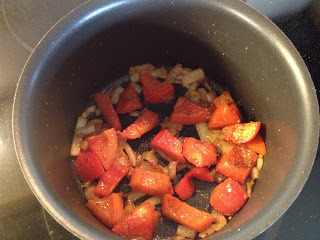
From Chris Pedersen
Time 20 minutes
Yield 2 servings
Category Main Course
Cuisine Vegan, Vegetarian
Ingredients
1 Tbsp olive oil
1/4 yellow onion, chopped
1 garlic clove, crushed
1/4-1/2 red pepper, chopped
dash of chili powder
dash of cumin
1 tsp oregano
dash celery salt
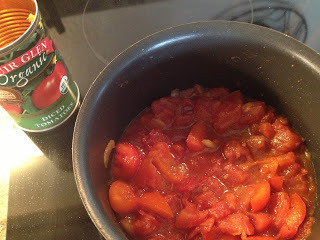 1 (14.5 oz) can diced tomatoes
1 (14.5 oz) can diced tomatoes1 (14.5 oz) can red kidney beans, drained and rinsed
grated cheese or Daiya
Directions
1. Heat olive oil in sauce pan over medium-high heat. Add onions and stir. Cook until onions are translucent.
2. Add garlic and stir.
3. Add seasoning amounts to your liking and stir.
4. Add peppers. Cook until peppers have softened then add tomatoes.
5. Add beans and cook until hot. Serve with grated cheese or non-dairy cheese (e.g. Daiya).
For your KISS challenge, should you choose to accept it, survey your spices and open up the pantry and refrigerator. Now make up a meal and report back how it turned out.


Published on May 10, 2013 15:17
May 3, 2013
What's the Scoop on Probiotics and Prebiotics?
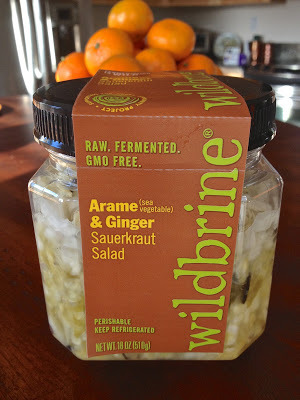
In a recent post about bacteria and the role it plays in our health, I mentioned probiotics and prebiotics. There was a lot to digest (ahem!) there. So I feel the need to help you along with some practical information.
I believe that Americans in general are bacteria-starved. They have upset their body's ecological balance and, as a result, get hit regularly with illness (minor and serious).
The Solution

Probiotics
There are two ways to get bacteria back at work in our bodies.
Eat/drink fermented foods
Take a probiotic supplement
Eating fermented foods provides 1000 times more bacteria than taking a probiotic supplement.
I like to recommend PB8 because its the brand prescribed by my functional medicine doctor.
In the area of fermented foods, I recently discovered some new products in my favorite grocery store, Nugget Market: Wildbrine sauerkraut salad and Synergy Kombucha tea. Both are raw and organic foods.
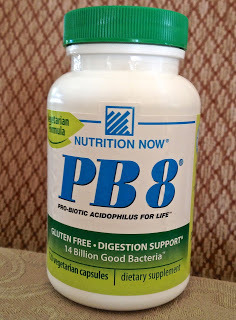 I drink about 8 oz of Kombucha every day. There are several flavors to choose from. The sauerkraut gets mixed into my raw, cut-up veggie salad. It adds a zip to the flavor I really enjoy. You can also eat yogurt, but I'm highly suspect unless the ingredient's label states live bacteria. Many yogurts are pasteurized once the cultures are added, which kills the bacteria. Duh!
I drink about 8 oz of Kombucha every day. There are several flavors to choose from. The sauerkraut gets mixed into my raw, cut-up veggie salad. It adds a zip to the flavor I really enjoy. You can also eat yogurt, but I'm highly suspect unless the ingredient's label states live bacteria. Many yogurts are pasteurized once the cultures are added, which kills the bacteria. Duh!Prebiotics
Similar to probiotics you can take a supplement or you can eat foods that provide nourishment for your friendly bacteria. I recommend the eating route.
Here's s list of foods that provide fuel to your good bugs: onions, garlic, milk (including breast milk), bananas, wheat, oats, artichokes, asparagus, leeks and chicory. I know I eat many of these foods on a regular basis.
You can order 100% raw and organic cultured vegetables from Immunitrition.
Also, check out this video to make your own (its very easy) fermented vegetables:
Start a routine to build up your bacteria and see if you start feeling better. You'll manage to ward off those nasty bugs going around that you always seem to get smacked with.


Published on May 03, 2013 17:00
April 26, 2013
Potato-Less Potato Salad

I love potato salad. My mom made the best and I've always tried to duplicate it. But now I generally avoid potatoes except for a few recipes—like this Hearty Vegetable Stew. Why? Well they're starchy and quickly turn to sugar in your body. They're inflammatory as opposed to their beta-carotene cousin, the sweet potato or yam, which is anti-inflammatory.
So I decided to duplicate my mother's recipe, as best I knew how, with a healthier substitute. I've got to give my sis-in-law, Marion, credit. She gave me the idea when she served a mock-potato salad at Easter.
Did you guess cauliflower as the worthy stand-in for potatoes in this salad recipe? It's 28 points lower on the Glycemic Index, a numerical scale used to indicate how fast and how high a particular food can raise blood glucose (blood sugar) levels. It's mildly anti-inflammatory (11) as opposed to potatoes, which are moderately inflammatory (-179).
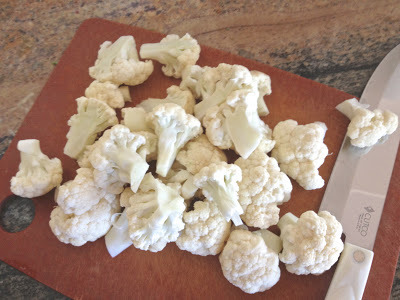
So let's build a new standard for that summertime icon, formerly known as potato salad. Start with cauliflower cut into florets. Steam until firm. Don't overcook. Cool and then cut into bit-size pieces.
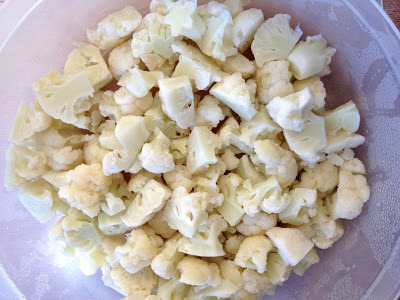
Mix all the veggie ingredients together and add chopped eggs. I always buy organic eggs thus ensuring the chickens were not given antibiotics, hormones or GM feed. And I try to source locally from friends with chickens or a store that carries local eggs.
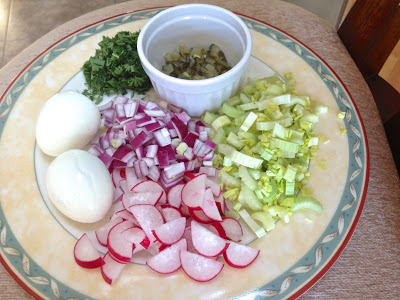
The dressing is super simple. I use it for lots of purposes like dipping steamed artichoke leaves. Make sure you use a real food mayonnaise. I use the Organic Mayonnaise from Trader Joe's.
Potato-less Potato Salad
From Chris Pedersen
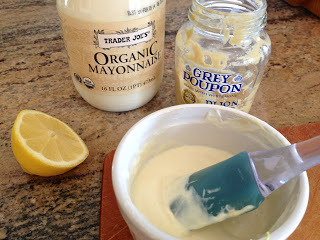 Yield 6-8 servings
Yield 6-8 servingsCategory Salad
Cuisine Vegetarian
Ingredients
Head of cauliflower, cut into florets
2 organic hard-boiled eggs, chopped
1/3 C chopped red onion
1/2 C chopped celery
3 Tbsp chopped pickles
2 Tbsp chopped fresh parsley
4-5 radishes, cut into half-moons
1/4 C organic mayonnaise
1 Tbsp dijon mustard
1/2 tsp fresh lemon juice
salt & pepper to taste
Directions
1. Steam cauliflower for about 15 minutes until fork tender. Cool and transfer to fridge.
2. Prep the egg and veggie ingredients and add to large bowl.
3. Cut cooled cauliflower to bite-size pieces, add to bowl and stir.
4. Mix mayo, mustard and lemon juice together. Add to bowl and mix.
5. Salt and pepper to taste and serve.
Let's come up with a better name for this delicious potato-less salad. Leave your name ideas in the comments.


Published on April 26, 2013 16:30
April 24, 2013
Wisdom Wednesday

 Tip
TipStay away from GMO corn. Unless it's organic or carries the Non-GMO seal, don't eat it. Tests show GMO corn contains 13 ppm of glyphosate (poison in Roundup®) plus high levels of formaldehyde. The EPA standard for glyphosate in American water supplies is 0.7 ppm, and organ damage in animals has occurred at levels as low as 0.1 ppm. Plus a 2012 nutritional analysis shows GMO corn severely nutrient deficient.


Published on April 24, 2013 02:30
April 19, 2013
What's Bugging You?

Photo by Jayanta Behera
Last December I had a run-in with a few bugs. You know. Those nasty bacteria that can send you into a feverish episode requiring you to step back, rest and get your body back on track. Might also involve taking an antibiotic to kill off the bad guys. Of course there's always some collateral damage and good guys succumb to the process.
The Inside Story
Science is just beginning to learn which bugs inhabit our bodies and how vitally important they are to being healthy.
In a healthy, balanced gut (aka gastrointestinal tract) you'll find:
100 trillion microbes
85% good bacteria and 15% bad
10,000 different kinds of bacteria
10 times more bacterial cells than total body cells
95% of the genetic material of your body is NOT yours!
Bacteria are active participants in life-processing functions of the body: metabolizing food, releasing vitamins and breaking down toxins. Most important, they are key to a robust immune system and it's ability to fight infection and disease.
Recent studies at the University of Pennsylvania show that mice grown germ-free or on antibiotics are less able to fight infection. This same effect can be seen in people who often get secondary infections after a long course of antibiotics.
The Outside Story
On another level, antibacterial soaps, cleaners and hand-wipes are everywhere (except in my household). American's obsession with hygiene not only affects the body's ability to fight infection, but may cause it to turn on itself. There has long been suspicion among medical researchers that the rise of autoimmune disorders such as asthma could be promoted by the sterility of our homes compared to when we lived less concerned about germs.
Diversity Is a Gut Instinct
Our gut community of microorganisms is crucial—the more diversity the healthier we are. Gut makeup is determined by age, where we live and diet. We cannot be whole without a diverse and vast array of microbes swimming around inside and crawling around outside. It's what keeps us able to fight off disease and avoid the onset of the many autoimmune disorders now plaguing our health system.
A recent study in the journal Science found that the presence of bacteria on the skin offered another immune protection than what's provided by the gut. Bacteria on your skin protects you from infection AND even allergies. Your skin is a first line of defense for infection. We've also learned that gut bacteria and skin bacteria communicate in some way to provide effective defenses.
Breaking It Down
Here's 8 tips on how to optimize and protect your microbial community:
Clear your house of antibacterial products
Take a probiotic
Eat more raw foods
Add cultured and fermented foods to your diet
Consume only meat and dairy from grass/organically-fed animals labeled as antibiotic-free
Avoid fructose and sugar—it wrecks havoc on your immune system
Don't take antibiotics unless you have a bacterial infection
Get outside—get your hands dirty and plant a garden
The expanding body of scientific evidence that bacteria in the gut play a role in health and disease (including asthma, allergies, autism, skin problems and autoimmune disorders) should cause us to think about how that affects our lives. Here are some important findings to keep in mind about bacteria:
80% of all antibiotics produced are used in agriculture. So even if you're not taking antibiotics, you may be exposing yourself to antibiotics by what you are eating.
Knowing that antibiotics are used to produce heavier animals for market, scientists are finding a possible link between antibiotic use and risk of obesity in children.
Interest is increasing in the role of prebiotics, indigestible food ingredients that provide no nutrition to people, but provide nourishment to the friendly bacteria living in the gut.
If prebiotics are food for friendly bacteria, then sugar and processed foods are the fuel for bad bacteria.
The key factor behind cancer appears to be ecological rather than genetic.
If you want to learn more about the process of fermenting foods and Gut and Psychology Syndrome (GAPS) Nutritional Program check out this series of videos, an audio interview with Dr. Natasha Campbell-McBride.
Now that you know you harbor a veritable zoo inside your body, one that's essential to your health and being disease-free (raise your hand if this is news to you...), shouldn't you be feeding it well?
Take heed for your own health and spread the word. Use the share tabs below this post to tell your friends about this very important health information.
Lots of stuff to chew on in this post. Fire away with the questions. You surely have many. What did you find most compelling in this post?


Published on April 19, 2013 17:25
April 12, 2013
Hearty Vegetable Stew
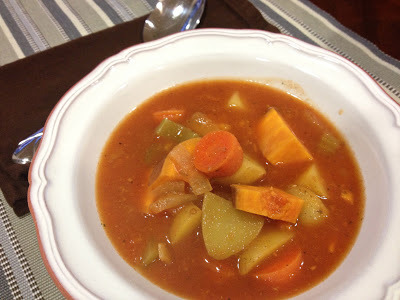
Easy recipes—that's me. This recipe came into my email inbox from Veronica Grace, vegan chef and photographer, over on Forks Over Knives. I recommend you get on their email list for great health information and recipes.
If you haven't seen the documentary film, Forks Over Knives, I recommend you do. Backed by information from the famous China Study, it asserts that virtually all disease can be averted, controlled or even reversed by eliminating animal-based and processed foods from our diet. In addition, the film shows food as medicine put to the test.
Crockpot Directions
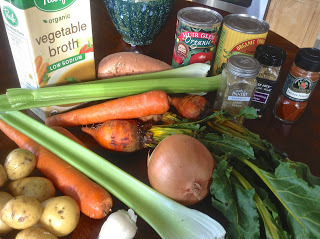
I made this stew on the stovetop, but you can also use a crockpot. If you do, slice the yam (rather than cube it) or it will become too soft. Add the veggies to the crockpot in the following order: carrots, potatoes, beets/turnips, yam, celery and onions. Blend the tomatoes, seasoning and dates and pour over top. No broth needed.
Cook on low for 6-7 hours or high for 5 hours. Test the potatoes to doneness. Adjust seasonings and serve.
Hearty Vegetable Stew
From Veronica Grace (Forks Over Knives)
Yield 6 servings
Category Soup
Cuisine Vegan, Vegetarian, Gluten-free
 Ingredients
Ingredients1 oniom, diced
6 cloves of garlic, minced
10 baby potatoes quartered or 2 med. potatoes cubed
1 yam, cubed
2 golden beets or turnips
3 carrots, chopped
3 stalks of celery, chopped
1 onion, diced
6 cloves of garlic, minced
4 C of low-sodium vegetable broth
8 fresh tomatoes or 28 oz can of tomatoes
6 dates soaked in a bit of water
1 tsp cumin
2 tsp of Italian (or favorite) herb mix
1 tsp smoked paprika
salt & pepper to taste
Stove Top Directions
1. Saute onions and garlic in 1 cup of vegetable broth over medium heat in large pot while you chop the remaining veggies.
2. Cut potatoes, beets (or turnips) smaller than yams because they take longer to cook.
3. Add veggies to pot. Add remaining 3 cups of veggie broth. Should almost cover all the veggies.
4. Blend tomatoes, seasonings and dates in blender, then add to pot.
5. Cover and bring to boil. Then reduce heat to medium and cook for 45-55 minutes--until the potatoes and beets/turnips are soft.
6. Season with salt and pepper. Use a potato masher to mash about 1/4 of the soup to thicken it and make it into a chunky stew. Serve.
Now doesn't that sound easy? What's your favorite spice blend? I've got several.


Published on April 12, 2013 14:44
April 10, 2013
Wisdom Wednesday
Published on April 10, 2013 15:00

